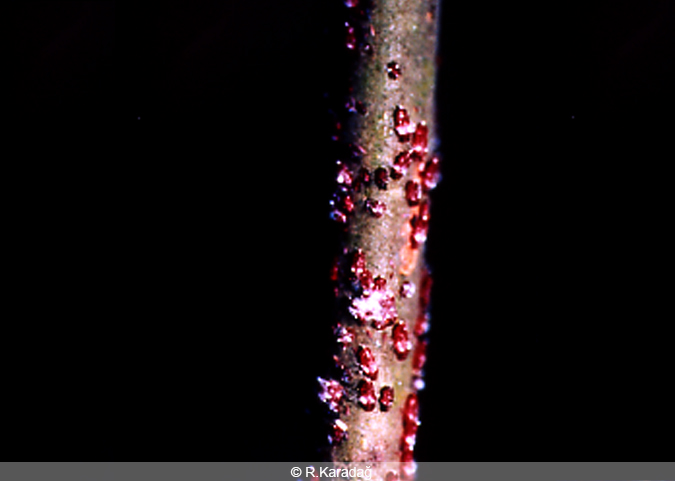This insect is found in India and Southeast Asian countries such as Thailand , Malaysia , Cambodia , Laos , and Indonesia . These insects are not bound to a specific host plant, but rather settle on quite different varieties. The wingless, fertilized females settle on young twigs of the plant and begin to suck the sap. They secrete a resin-like material that eventually covers the whole colony and forms a mass around the twigs that encloses the insects, which contain the dyestuffs. These twigs are gathered and treated. The crusty mass contains two groups of useful substances: red dyestuffs for dyeing and resin for shellac for furniture and other items.In order to obtain the water-soluble dyestuffs, the mass is separated from the twigs, crushed, and then rubbed on a rough surface under water, which carries off the dyestuffs, leaving the insoluble resin for later use. Lac is definitely a renewable product. It grows in generous quantities without any human assistance, wild, so to speak, in the forests of the countries where it is native to. Lac is also cultivated in Thailand.
Historical Data
The dark red of lac dye has been found in Roman textiles in Palmyra and, therefore, it was imported from India to the Near East more then 2,000 years ago. Carpet manufacturing was under the patronage of the court, in the Safavidian Persia, Ottoman Empire and Indian Moghul Empire.Lac was preferred rather than madder which fades on silk. After the introduction of the American cochineal, the use of lac in dyeing was decreased. By the beginning of the 19th century, the use of lac disappeared outside the Asian countries. In India , Thailand , Malaysia and Laos , the use of lac for dyeing silk has survived up to now. Silk material dyed with lac is very precious in these countries now, and gaining importance around the world. Around 1500 BC, lac was mentioned in one of the oldest kingdom texts of India Atharvaveda . Medicinal properties of the lac was highlighted there but, it was well known for its excellent dyeing properties for linen according to Panini (4th century BC), and in the book named Samyutta Nikkaya (3rd-2nd centuries BC).it was described in Nayadhammakahao (454 AD) that dye was obtained by pressing lac mass and another method was described in the book named Ksemandra (10th century AD) by decoction. Linen was a prevalent textile fibre in India and presents little affinity to the insect dyeing. Lac dyeing was used especially in the silk, wool and the cashmere weaving regions. In episodes of Ramayana lac was identified as the source of the red dyed textiles probably woven in Assam , which was in the old Indian silk trade, between the end of 13th and the beginning of the 16th century. In several carpets dated from the beginning of the 17th century, in floral motifs of Lahore and cashmere shawls dated from the end of the 18th to the beginning of the 19th century, the red and rosy colours were provided from lac (in combination with the Indian madder [ Rubia cordifolia]) in two carpets). The lac was very early appreciated in silk weaving, in China . According to Chang Po, author of Wu Lu (Annals of the south-west of China ), written in 320 AD, the lac was used for dyeing silk in scarlet red. Until the arrival of the American cochineal in China , the lac remained as principal source of insect dyeing for red colour among the Chinese dyers. The European travellers Vasco de Gama, Duarte Barbosa and Garcia da Orta, mentioned that various regions of Indo-China were the source of the lac in the 15th and the 16th centuries. In Indo-China the collected lac probably came from Kerria lacca and Kerria chinensis.

